Why is methane so important in the climate fight? A quick breakdown


· 11 min read
We’ve been told that slashing methane climate pollution this decade is critical to efforts to rein in “global boiling” as United Nations Secretary General Antonio Guterres aptly put it recently. But what makes this type of climate or greenhouse pollution different from the others?
Methane (chemical formula CH4, if you remember your high school science) is the main component of so-called “natural gas”, a moniker given to it by the gas industry to make it seem less harmful.
When you burn anything that includes carbon (the “C” in CH4), the main climate pollution is carbon dioxide. But methane also directly contributes to global boiling when it is released into the atmosphere unburnt. It is often found in coal deposits (hence the phrase coal seam gas). Releases from coal mines, gas wells, pipelines, and buildings, where it is used, are common.
It’s also burped or farted in large quantities by ruminant animals, particularly the cattle that produce beef and dairy products, and is a byproduct from landfill waste.
If people think about global boiling and greenhouse emissions at all, they might blithely assume that when we stop adding more climate pollution into the atmosphere (otherwise known as reaching net zero emissions), the climate will be back to “normal”. That when climate pollution peaks, heating will peak too, and as we reduce global emissions to zero it will gradually get cooler again, back to around the level at which humanity thrived for the last few thousand years.
Sadly, people thinking that way are in for a rude shock.
The 2010s were the coolest and least extreme (weather-wise) that we, and most likely our children will ever experience for the rest of our lives. They were also the hottest decade on record. The 2020s are already shaping up to eclipse the 2010s as the hottest on record. At a minimum, the next three decades will each be hotter and more tempestuous than the last.
Why? Because what matters to the climate system is the overall level of climate pollution in the atmosphere. Not the amount we emit per year, but the cumulative amount bouncing around in the atmosphere doing its heating thing.
Every year humanity continues to emit climate pollution, it’s like throwing another blanket on the bed – more insulation means you’ll feel warmer. Too many blankets and you’ll be too hot.
That’s because many of the heating gases, including carbon dioxide (most of which comes from burning coal, gas, oil and its derivatives like petrol and diesel), nitrous oxide and the industrial gases we use in everything from refrigerators to TVs to spray cans, generally hang around in the atmosphere for a long time typically from a century to thousands of years.
Until we stop releasing these climate pollutants, the overall level of pollution in the atmosphere keeps going up. Which means so does the heat. A hotter atmosphere is more energetic and can hold more water. Until we stop releasing climate pollution, weather extremes just keep getting worse.
Yet when we stop releasing new climate pollution, things don’t go back to “normal.” We still have all those blankets on the bed. They’ll eventually come off, but that process will take between centuries and millennia. All that happens is that it stops getting even worse.
And that’s if we’re lucky. Because the slower we stop polluting, the more likely we trigger irreversible natural tipping points that will turbo charge global boiling. Meaning that even if we get to zero climate pollution made by us, it still keeps getting hotter. Scientists think some of these tipping points (or feedback loops) might start within the next couple of decades, given the rate we are currently polluting.
An example of a tipping point (scientists refer to them as “positive feedback”) relates to declining Arctic sea ice. Light coloured surfaces reflect a lot of the sun’s heat back into space, so a certain level of ice in the Arctic helps maintain a climatic equilibrium. Sea ice cover waxes and wanes with the seasons, but due to the extra pollution blankets we’ve been adding, it has been on a downward trend, exposing more of the Arctic Ocean. Dark water absorbs heat, raising temperatures so sea ice is less likely to form and accumulate. At some point, there will be enough exposed water in the Arctic Ocean that the accumulation of heat will overwhelm the development of sea ice, creating a feedback loop that will accelerate the decline of ice, regardless of efforts to reduce climate pollution.
There are about a dozen of these tipping points, and triggering one amplifies the chances of triggering others.
How can methane help, or really hurt?
Unpacking the importance of methane requires a basic understanding of some key concepts:
Global Warming Potential (GWP) compares how much a given mass (e.g. 1 kilogram) of a particular gas traps heat relative to carbon dioxide. Carbon dioxide always has a GWP of 1.
GWP also has a time dimension. Long lived gases do their heating thing over longer time frames than gases that break down quickly in the atmosphere.
GWP has a number next to it, typically 100 or 20, relating to the number of years the measurement of comparative warming potential relates to. Global convention is for countries to express their emissions in terms of the 100 year GWP.
Methane happens to be a fairly short-lived gas. It breaks down in the atmosphere after one to two decades as shown in the red dotted line in Figure 1. But over that period, it warms at a much higher rate than carbon dioxide.
Figure 1. Time taken for various greenhouse (heat trapping) gases break down or dissipate in the atmosphere

According to the US EPA, the GWP20 of 1 kg of methane is 81-83, meaning that in a 20 year period that kilogram does the heating of 81-83 kg of carbon dioxide. But because it breaks down fast relative to carbon dioxide, which can persist in the atmosphere for hundreds of years, the GWP100 of methane is only around 27-30, meaning 1 kg of methane does the heating damage of 27-30 kg of carbon dioxide over a century.
Even though methane in the atmosphere is a trace gas at around 2 parts per million (vs 420 for carbon dioxide), its high GWP means it has a disproportionate impact on the climate. Just like arsenic, you don’t need much to have a big impact.
In fact, methane is estimated to be responsible for about 30% of the rise in global temperatures since the Industrial Revolution began around 1750. Despite being short-lived, its concentration in the atmosphere has rocketed up by 150% (from less than 800 to more than 1900 parts per billion). In comparison, long-lived carbon dioxide concentration has only increased by about half (from about 280 to 420 parts per million).
Figure 2. Increase in concentrations of atmospheric methane and carbon dioxide


Sources: (1) https://www.csiro.au/en/news/All/Articles/2020/July/emissions-of-methane-are-rising
(2) https://blog.csiro.au/co2-data-twitter/
Methane pollution’s relatively short but impactful life in the atmosphere becomes really important when you remember that, given how long-lived other greenhouse gases are, only by ending methane emissions can we reduce the number of climate pollution blankets on the bed in human timescales.
Little more than 10 years after achieving an overall reduction in global methane pollution, it will have largely dissipated in the atmosphere, meaning it is no longer acting as a blanket.
If we get it right, slashing methane pollution this decade (and keep reducing in the 2040s and beyond) might see the number of parts per billion of methane in the atmosphere peak and start to decline, kicking a blanket off the bed as it does so.
Deep, quick cuts to methane pollution are critical to avoiding overshoot beyond the 1.5 degrees of global heating that scientists have warned could trigger multiple natural tipping points.
That’s why, at the big climate conference in Glasgow (COP26 in 2021), a group of countries pledged to reduce methane pollution by 30% by 2030. That wouldn’t go far enough, but if it were achieved it would be a good start.
The good news is that some measures to reduce methane pollution are not only easy, but many are cost effective for the polluting companies: fixing leaks from buildings and pipelines and avoiding “fugitive” methane releases at coal mines and wellheads (including abandoned ones). After all, methane gas leaks represent wasted products for gas producers and distributors.
But first, you need to know where those leaks are. Traditionally, coal, oil and gas companies have estimated their methane leaks using industry coefficients, and countries have allowed those estimates to go into national climate pollution reporting numbers without much scrutiny or verification.
Independent measurement using special imaging cameras that can detect methane from ground-based, airborne and satellite methods, has often found much higher rates of leakage. Sometimes orders of magnitude more. Various teams including methanesat.org and ghgsat.com are working to develop satellite networks that can constantly detect and measure methane plumes, providing precise data to companies, governments, and supranational organisations.
Yes, cattle, landfill waste and a few other sources also need to be targeted. There are emerging solutions for some of that too such as livestock feed supplements that somewhat reduce the amount of methane released from cattle. Many landfills are separating organic waste and/or trapping methane and using it productively. Ultimately, humans will need to consume less beef and dairy products, consequently reducing herd sizes.
But the most decisive thing we can do to stop methane emissions is to end approvals of new fossil fuel extraction and infrastructure. If your bed’s too hot, the logical thing to do is stop adding blankets.
And if we stop permitting more coal, oil and gas extraction, we will become fully focused on moving to renewable forms of energy; on electrifying our homes, businesses and transport; on replacing oil, gas and coking coal for high heat and other industrial processes. Many existing mines and wells have existing approvals to produce for decades, so it’s not as if we won’t have time to transition. As it is, about 60 percent of oil and gas and 90 percent of coal reserves must remain unextracted for even half a chance of meeting the 1.5 degree target.
The more we continue to indulge the industry that has done the most to deny and delay solutions to global boiling, the less likely we are to turn down the heat. We have a great chance to quickly break down methane pollution as we break up with its biggest producers. We must act with absolute urgency to avoid levels of global boiling that trigger irreversible tipping points.
illuminem Voices is a democratic space presenting the thoughts and opinions of leading Sustainability & Energy writers, their opinions do not necessarily represent those of illuminem.
illuminem briefings

Pollution · Wellbeing
illuminem briefings

Pollution · Nature
illuminem briefings

Pollution · Public Governance
The Guardian

Pollution · Nature
Futurity

Carbon · Pollution
The Ecologist

Pollution · Public Governance